There are now lots of EVs on the market but only two of them can be characterized as affordable alternatives to non-electric cars.
One of those two being Nissan’s Leaf.
It doesn’t go as far as other EVs – and it’s not nearly as quick, an EV selling point. But the fact that it’s a car within the means of people who cannot afford a luxury-priced car is a selling point all its own.
What It Is
The Leaf is Nissan’s entry-level electric car and one of only two such on the market right now deserving of that designation, the other being Chevy’s Bolt.
Both sticker for about $15,000 less than the next-least expensive EVs, models like the Hyundai Kona ($34,845) and about $20,000 less than EVs like the Tesla Model 3, that start at well over $40,000 to start.
The Leaf S stickers for $28,040 to start. The catch is that’s with the standard battery that gives you just 149 miles of best-case range on a full-charge. If you want more range it’ll cost you $36,040 for the SV plus, which has a best-case range of 212 miles.
Chevy’s Bolt EV costs less – $26,500 to start – and it comes standard with a battery that can power its electric drivetrain for 259 miles, best-case.
It is, however, a much smaller (subcompact-sized) car that has a bit less room for cargo behind its second row (16.6 cubic feet vs. 23.6 for the Leaf).
What’s New for 2023
There are just two trims available now – down from five last year. Both trims get revised front-end styling and the “Nissan” badge is illuminated.
What’s Good
Cost is more within range.
About 30 percent more room for cargo (23.6 cubic feet) behind its back seats than Chevy Bolt has (16.6 cubic feet).
Accelerates smartly.
What’s Not So Good
Range is low – unless you pay more.
Bolt has 57 cubic feet of total cargo capacity with its back seats folded down.
Regular use of its ability accelerate smartly rapidly reduces the range remaining.
The standard Leaf is powered by a 147 horsepower electric motor fed by a 40 kWh lithium-ion battery pack. This version can travel up to 149 miles on a full charge. “Up to” is italicized to emphasize the fact that, as with all EVs, how far the Leaf actually goes is highly variable.
It isn’t just about whether you drive with a light – or heavy – right foot, the major factor that affects how far a non-electric vehicle will actually take you, as opposed to how far the manufacturer says it will.
There are additional factors – some of them you have no control over – such as the weather. An EV’s range is greatly affected by cold and heat – as well as use of the heater (and the AC, to cool you down). Heat and cold don’t appreciably diminish a non-electric car’s range, nor use of the heater and AC. So as long as you don’t drive with a heavy right foot, a non-electric vehicle will almost always go as far as advertised, or close to it.
With electric vehicles, you may find that the range you thought you had is 20 percent less than what you thought it was. If your EV didn’t have much range to begin with, as in the case of the Leaf with its standard battery, your range is limited. The loss of say 20 percent of its full-charge 149 mile range would leave with you about 130 milesa of actual range; this may be enough range for daily short-range commuting – but it won’t take you much farther than that.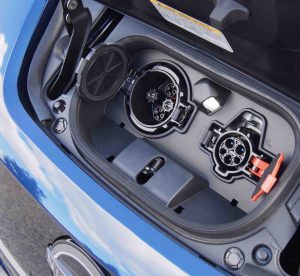
Especially because the Leaf’s DC “fast” charger port is not compatible with many of the latest public, high-voltage “fast” chargers. That means plugging in at home, where the “fastest” you can recharge a Leaf is about eight hours, using a 240 volt hook-up. Be aware that many homes do not have one of these already installed which will mean paying to have it installed by an electrician. This is not a mandatory expense because it is possible to recharge the Leaf – and any other EV – using ordinary household (120V) outlets, which every home already has. Be aware, however, that charging this way will take all day – and all night.
Nissan does offer an upgraded-range Leaf with a 62 kWh battery pack. This one advertises a best-case range of 212 miles, which helps to compensate for the loss of range due to cold/hot weather and use of necessary accessories, such as the heater and AC. It is still, however, about 40 miles less range than the Leaf’s main rival – Chevy’s Bolt – comes standard with.
The $26,500 base-price Bolt can go up to 259 miles – which is much farther than the $28,040 base-price Leaf goes.
For $1,540 less.
And for a lot more – $9,540 more – the Leaf with its optional 62 kWh battery still doesn’t go as far as the $26,500 base-price Bolt.
The good news – for Nissan – is that the Bolt isn’t any quicker than the Leaf. Both of these EVs can get to 60 in about 6.4 seconds, which is quick relative to the typical non-electric economy car.
Quickness only takes you so far.
Arguably, the EV’s chief deficits – they don’t go far enough on a charge and they take too long to recover charge – are the result of focusing so much on how quickly they accelerate. This includes the Leaf.
If we were talking economy cars, this would be self-evident. Toyota does not put a V8 in the Corolla because getting to 60 in six seconds isn’t a priority for Corolla buyers. They want an efficient – and an affordable – car.
It takes more power to go faster, sooner – whether in the form of gas or electricity. But there is a difference. There is a lot of energy locked up in a gallon of gasoline, which only weighs about six pounds. In an economy car, a gallon – six pounds – will power the car for 35-40 miles. Five gallons – about 30 pounds of liquid power – will propel the same car close to 200 miles.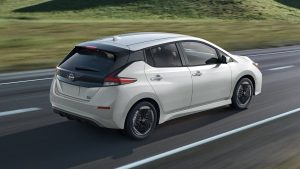
Now, electricity is essentially weightless. But the battery that is necessary to store it, as in an EV, is not. A typical small EV like the Leaf has about 1,000 pounds of battery pack in it, which is why this compact-sized car weighs 3,509 pounds – about 1,000 pounds more than a same-sized economy car like Nissan’s Versa.
The Versa takes longer to get from zero to 60. But it goes for much longer. Almost 300 miles in city driving, or nearly twice as far as the base-battery Leaf can go, best-case. If the Leaf weighed even 500 pounds less, it could probably go nearly as far as the Versa in city driving.
But it also wouldn’t get to 60 in just over six seconds.
Well, so what? No one expects an economy car to accelerate as quickly as a sports car. Yet all EVs are designed to accelerate like sports cars. Why? To sex them up. To make them more emotionally appealing. But this is silly, if the object is economy – and affordability. Both of which tie into the supposed goal of getting more average people into EVs. This is not going to happen so long as most people can’t afford EVs – which are unaffordable chiefly because they have huge, heavy and expensive battery packs – necessary to make them accelerate like sports cars.
These huge and heavy battery packs also slow them down – or rather, slow you down – in terms of how often you have to stop and wait to recharge them.
Nissan – and Chevy, with the Bolt – have tried better than most to focus less monomaniacally on quickness-uber alles. But both of these cars are gimped by the very thing they tout.
The Leaf, like all EVS, jumps when you touch the accelerator. It as quick from a dead stop as V8 muscle cars were, back in the day. The thrust wanes as you pass about 40 MPH but it still goes like a sports car all the way up to about 80. And it can go considerably faster than that.
But as you’re doing that, watch the range indicator. Watch how much power you consume as you go. It is comparable to watching the gas gauge needle in a V8 muscle car lean noticeably toward “E.” But the critical difference is that no matter how much gas you burn, it is fast and easy to get more. It is not fast – and sometimes, far from easy – to get more electricity into an EV’s battery.
Readers of this column have read about my saga finding “fast” chargers – and finding working ones. It is not uncommon to find every third one doesn’t. This problem is compounded as regards the Leaf because its “fast” charging system isn’t compatible with some “fast” chargers. If you’ve run really low on range, assuming you’d be able to recharge “fastly,” you may find you have a problem. It’s more of a problem in the Leaf because of its modest range. Remember: If you run out of electricity it is not like running out of gas – because you cannot walk a can of kilowatt-hours back to your conked out EV.
These dilemmas would be lessened if not eliminated if companies hoping to mass-market EVs stopped focusing on building them quick in favor of building them light. Or at least, as light as possible. A Leaf that could go – realistically – 250 miles on a full charge would probably sell a lot better than this one, even if it took 10 seconds to get to 60.
That latter, by the way, has never been an impediment to the Prius hybrid, which sells hugely. Probably chiefly because it can go 700 miles on a tank, which it can because it does not go zero to 60 in six seconds. 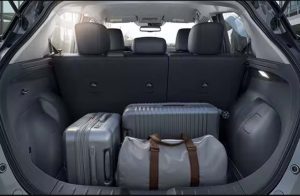
At The Curb
The Leaf is about the same overall size as the Versa but has about twice as much room for stuff – cargo – because it is a hatchback with a liftgate rather than a sedan with a trunk.
It also has significantly more space for stuff with its backseats up than its chief electric rival, the Chevy Bolt – which only has 16.3 cubic feet behind its second row vs. the Leaf’s 23.6 cubic feet. The Bolt fires back with 57 cubic feet of total space for stuff, but this is only available if the back seats aren’t – for passengers.
In other words, you have to choose: People – or stuff? 
The Leaf has enough space with its seats up to be more practical for people and cargo carrying at the same time. The Bolt is better suited to commuter-car duty, even though it has the range that’s lacking in the Leaf. If the Leaf could go farther, it would be the one to take the family on a trip in.
One of the Leaf’s best features, however, is the location of its charge port. It is not on the left or the right side. It is right under your nose – up front. This makes it much easier to get close to where you need to plug in. Some will recall when cars often had their gas doors behind the rear license plate. This meant you didn’t have to line up with the pump on the left or the right – depending on which side of the car the gas door was on. You just drove up.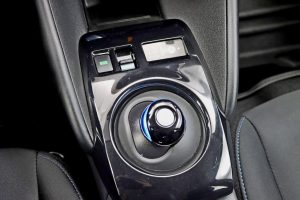
Same thing here.
You may need to back out, but that’s less hassle (and potential wait) than not being able to line up.
Other than its toggle-type gear selector (which isn’t really that because EVs don’t have gears because they don’t have transmissions) and EV-specific instrument cluster, the Leaf is pretty unobtrusively EV. Its silent drive (and having to keep track of the range) being the main things that differentiate it from a “regular” car like the Versa.
It does wear “sensible shoes” – 16 inch steel wheels with plastic pop-on covers – which are economical and help keep the Versa’s price down as well as the cost of tires, when it comes to replace them. Larger “rims” are available – but contrary to the point.
Everything you need is standard in the base S trim: AC, a decent stereo with four speakers and Apple CarPlay/Android connectivity and power windows/locks, etc. All economy cars have these once-optionals now.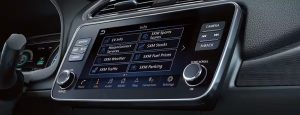
The less economical – insofar as what it costs – SV comes with luxuries such as heated/power-adjustable seats but bear in mind that everything that’s powered in an EV uses electricity and so uses up charge.
Nissan tried to eke more range out of the SV Leaf by giving it a heat pump-type heating system that’s more efficient than using a hot-wire (space heater-type) system but it is part of the reason why the SV costs $36k to start and for that reason is priced more in line with entry-luxury cars than economy cars.
You might pay less for an EV like the Leaf if you earned enough money to qualify for a $7,500 tax refund. But the catch for most people is they didn’t earn enough to qualify for that much back – or even any. In which case the cost of a Leaf or any EV is much higher than the cost of a non-EV and you may want to take that into account before you buy one, if you hope to save money by buying one.
The Bottom Line
The Leaf is, arguably, what an EV ought to be – almost.
It is an excellent short-range transportation appliance. It is almost affordable.
If it were lighter – which it could be, if it stopped trying to sell quickness rather than efficiency – it might be something more affordable and so economical than this one is.
And then, perhaps, Nissan might sell more of them!
. . .
If you like what you’ve found here please consider supporting EPautos.
We depend on you to keep the wheels turning!
Our donate button is here.
If you prefer not to use PayPal, our mailing address is:
EPautos
721 Hummingbird Lane SE
Copper Hill, VA 24079
PS: Get an EPautos magnet or sticker or coaster in return for a $20 or more one-time donation or a $10 or more monthly recurring donation. (Please be sure to tell us you want a magnet or sticker or coaster – and also, provide an address, so we know where to mail the thing!)
My eBook about car buying (new and used) is also available for your favorite price – free! Click here. If that fails, email me at EPeters952@yahoo.com and I will send you a copy directly!


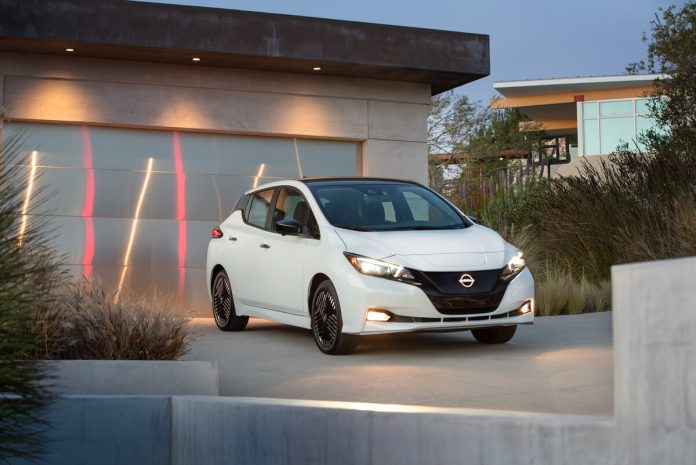

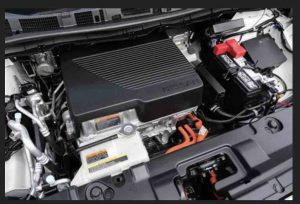
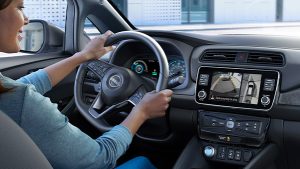
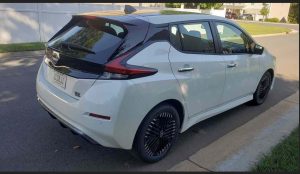








You appear to misunderstand how EVs work. Making these things less able to accelerate quickly isn’t going to help your range much at all. Maybe you could use a motor that weighed 50lbs less or something, but that’s the only savings you would see in the range.
If the Bolt was 0-60 in 12 seconds instead of 6, it would still require just as much energy to travel down the road at a given speed.
You are stuck in ICE thinking and somehow feel these things have big heavy, inefficient V8s in them.
That’s not how this works.
Hi Nate,
I understand very well how EVs work. Using power consumes energy. These vehicles are needlessly heavy in order to be powerful (and quick). Use the power and the range wilts. So why the focus on power and quickness?
As far as “inefficient”: A V8 does not need to carry around 1,000 pounds of energy storage device. If if it had 1,000 pound of fuel on board, it could travel for longer, continuously, than a dozen Teslas (swapping one fort another as each runs out of power).
Bundesverband Verbrennungsmotor e.V.
https://www.facebook.com/photo?fbid=586113033560798&set=pcb.586113276894107
“It takes more power to go faster, sooner”.
It actually does not. Fast acceleration actually does not waste any energy at all. Only braking, wind and tire resistance annihilates energy. What you say actually is a very common misunderstanding.
On the other hand, fast acceleration will reduce the longevity of your tires.
In theory, theory and practice are the same, but in practice, they are not
Electric motors (and gasoline engines) have an efficiency curve – there are certain power levels that are more efficient than others. The curve is broader in an electric motor, but still there, though electric motors are limited by the capabilities of their battery. Past a certain point, batteries are less efficient at delivering power, and lose energy to heat, same for wires. Heat is generated as a function of current squared, so twice the power output means four times the heat loss.
So, yeah, you are right, in a physics sense, there is no difference in the net kinetic energy of an object if the impulse applying that energy is short and powerful or gradual, but in the world of practical engineering, there is most certainly a difference, and EV’s (and gas cars) are engineered to be most efficient at steady state cruising speed, sacrificing their efficiency in other areas.
There may be small differences in either direction. You are right that the efficiency of the batteries decreases with higher loads, causing added heat loss in the batteries themselves.
Yet a brisk acceleration from a standstill, might not use noticeably more energy, than accelerating very slowly for instance onto the motorway. (If you accelerate like crazy at one red light, and have to panic brake at the next, then energy would be wasted. One way to use less energy that applies to both IC and electrical cars, is that unnecessary braking should be avoided, since this annihilates the dynamic energy).
Hi Jone,
I have driven most of the EVs currently available and in all of them, using the acceleration they’re capable of dramatically depletes the charge and so the range. This is much more evident – and severe – if it’s cold out. I grant that if you drive like a Clover – gingerly accelerating, coasting as much as possible – this is much less a problem. But then why bother building in all of this capability you can’t really/realistically make much use of, except occasionally?
Perhaps you have to brake more often, when utilizing the powerful acceleration often?
Hi Jone,
Regen only recaptures some of the lost energy. Not enough to make up for what’s lost. And – once again – I circle back to the elephant in the room, which is why we’re even debating the EV’s deficits given there is a far superior alternative to the EV. That being a car powered by a combustion engine.
I am just discussing physics, and I am quite knowledgeable about this area. Besides from that, I don’t have any strong opinions about which kind of car people should prefer. This must be up to the individual customer.
Amen, Jone –
And there’s the rub. EVs are being forced on us by forcing vehicles that aren’t EVs off the market.
Hmmm… have you reviewed a Bolt yet? Probably a better choice for most. Still hoping to see that first Tesla review. The latest news from them has some strong projections for future growth. The new Y with new battery tech especially looks promising. You will see the Cybertruck probably in 2024.
Still loving my Prius Prime!
Anon,
Though I don’t recall the details, Eric’s on GM’s shit list, so they don’t send him cars, either ICEV or EV, to review. If you take a look around, he hasn’t reviewed any GM product in recent years.
The biggest drawback to the EV remains time to refuel. [Well… +cost + cost to own]
Everything is a trade off. Small car = small battery = give up range or performance or both.
Even the smallest of EV’s taking 12 or more hours to recharge is a non starter for many.
Cost for what you get is another. I’d rather have the versa all day long.
No sale.
Sounds like a pretty good candidate for a second car. I’m about 5 miles from a Park and Ride lot that has twice daily commuter bus service. If I had the time to deal with the bus ride -remember buses stop often, it might make more sense.
Good write up, Eric. Just to be clear, the designers aren’t trying to make electrics quick, the electric motor is inherently a torque device, and provides 100% torque at zero RPM.
Your point is good though, electronic motor control always has a programmable acceleration curve. In industry the VFD (variable frequency drive) or an electronic DC drive (from cheap analog ones to very sophisticated ones) all have this feature to 1. Improve efficiency(economy) and 2. to protect the mechanical components downstream and make them last longer (also economy…)
Precisely why are these EV’s not limited to 12 second 0-60 times like a real economy car?
It doesn’t matter to me, I drive old diesels daily which makes the most sense of all. A TDI Golf mark 4 will get me close to 50mpg driven (as I do) for mileage. And I can get one by patient shopping and tolerance of worn out junk for around $2500.
‘Designers aren’t trying to make electrics quick; the electric motor is inherently a torque device, and provides 100% torque at zero RPM.’ — Ernie
Apparently, the 1,000-lb battery is needed primarily for range, which remains modest even so. Fast acceleration due to the constant torque of the electric motor is essentially a free side benefit. That is, limiting acceleration to a 12-second 0-60 time would offer only a tiny gain in range, I suppose.
Indeed, punchy acceleration probably is the only advantage that EeeVees inherently possess over gasoline-fueled vehicles. Take that away, and you’d be left with a real ugly duckling. EPA, are you listening? *wink*
The battery problem is energy density/capacity. The Lithium Ion packs are darned impressive in that standard, but not good enough in life expectancy and not even close to clean, efficient, effective liquid natural fuels (sometimes referred to as fossil fuels by those 50 years behind on the science).
I believe the Detroit Electric of 100+ years ago used Edison batteries, a nickel iron technology which can be run completely dead and seems to continue to work indefinitely. If one was concerned about the environment those would be far less toxic and wasteful, but of course they are really heavy versus their power capacity.
Battery tech has evolved a lot, but it needs a revolution to be up to powering cars/trucks/aircraft. Something like cold fusion or a nuclear battery.
Good luck with that.